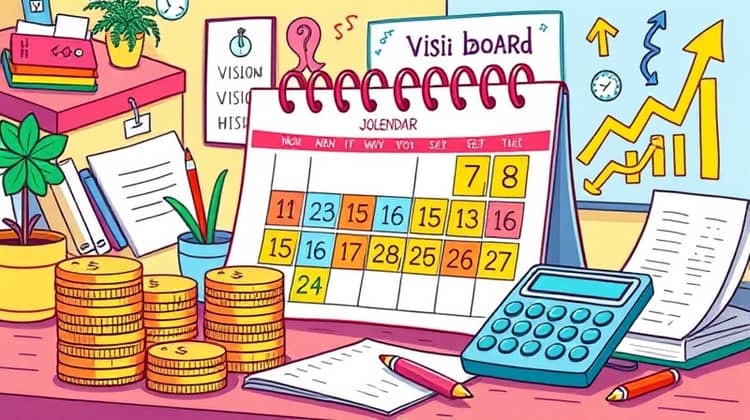Budgeting is not just about limiting your spending; it's a practical way to achieve your financial goals, especially when planning for a significant purchase. It can help you assess your needs, set priorities, and develop a clear financial strategy to ensure you can afford what you want without falling into debt.
In this article, we’ll outline a comprehensive step-by-step plan to help you budget effectively for your next big purchase, ensuring you’re financially prepared when the time comes.
Why Budgeting Matters Before a Big Purchase

Making a big purchase can be an exciting yet daunting experience. Whether you're planning to buy a car, a home, or take a dream vacation, it’s essential to approach your finances with a solid plan in place. Budgeting sets the foundation for financial stability and accountability, helping you minimize stress and avoid overspending.
When you budget for a big purchase, you create a roadmap that not only guides you through the process but also helps you stay committed to your financial goals.
- Establishes a clear financial goal.
- Prioritizes your spending needs.
- Helps you evaluate the affordability of the purchase.
- Encourages discipline and accountability in your spending habits.
By understanding why budgeting is important, you’ll be better equipped to make informed decisions that align with your financial capabilities. It’s the first step in paving the way for successful savings and eventual ownership of what you desire.
Step 1: Determine the Total Cost

Before you start saving, you need to know exactly how much money you will need. This means looking not just at the sticker price but also any additional costs associated with the purchase. For instance, if you’re buying a car, consider taxes, insurance, fuel, and maintenance costs.
Creating a detailed list of all potential expenses will give you a clear view of the total cost, enabling you to set a realistic budget.
- Research the item’s base cost.
- Include taxes and fees.
- Account for ongoing expenses (insurance, maintenance, utilities).
- Factor in any additional costs for necessary accessories or upgrades.
With a comprehensive understanding of the total cost, you’ll be well-prepared to make informed decisions about your budget and savings plan.
Step 2: Assess Your Current Financial Situation

Before you dive into saving, it's crucial to evaluate where you currently stand financially. Understanding your income, expenses, and savings will help you identify how much you can realistically allocate toward your big purchase.
Take a close look at your monthly budget, and determine what discretionary funds you have available to set aside for your goal.
- List your monthly income.
- Evaluate regular monthly expenses (rent, utilities, groceries).
- Identify any discretionary spending (dining out, entertainment).
- Calculate current savings and investments.
By taking stock of your financial situation, you’ll be better positioned to create a plan that focuses on your unique circumstances, allowing you to save effectively and efficiently.
Step 3: Set a Realistic Savings Goal

Once you have an understanding of your total cost and current finances, it’s time to set a savings goal. This goal should be realistic and attainable, considering how long you have to save and the amount you can set aside each month.
Remember that setting a specific target can enhance your motivation and commitment to saving. Breaking down your total cost into smaller, manageable savings increments can make the process less daunting and more achievable.
Step 4: Create a Timeline

To keep yourself on track, establish a timeline for your savings goal. This timeline will help you stay organized and provide a clear plan for when you expect to make the purchase.
Deciding on a timeline will also allow you to break your savings goal into monthly or biweekly amounts, making it easier to integrate into your budget.
Step 5: Find Ways to Cut Costs

As you work toward your savings goal, finding ways to cut costs in your current budget can significantly accelerate your progress. Identifying areas where you can reduce spending will free up additional funds to allocate towards your goal.
This exercise can also teach you valuable lessons about prioritizing needs versus wants, helping you make smarter financial decisions moving forward.
- Review your monthly subscriptions and eliminate unnecessary ones.
- Plan meals to reduce grocery spending.
- Limit dining out and entertainment expenses.
- Look for discounts or sales when shopping.
By strategically reducing your expenditures, you can boost your savings without needing to sacrifice too much of your lifestyle.
Step 6: Increase Your Income

Sometimes, cutting costs might not be enough to reach your savings goal as quickly as you'd like. In such cases, consider exploring ways to increase your income. This might involve seeking out part-time work or freelance opportunities that fit into your schedule.
Increasing your earnings, even slightly, can make a substantial difference in your overall savings progress.
- Consider picking up a side hustle or freelance work.
- Sell unused items around your house.
- Explore overtime opportunities at your current job.
- Invest in skills that could lead to a promotion or raise.
Enhancing your income will not only help you reach your goals faster but also give you greater financial security, which is essential for making significant purchases without stress.
Step 7: Choose the Right Savings Account

After establishing a savings plan and timeline, it’s time to select the right savings account to hold your funds. Look for an account that offers a competitive interest rate and no or minimal fees. This will ensure that your savings grow over time while you work toward your purchase.
Consider high-yield savings accounts or certificates of deposit (CDs) as options, as they often offer better returns than standard savings accounts.
- Research different banks and credit unions.
- Compare interest rates and fees.
- Look for accounts specifically designed for savings goals.
- Consider online banks for better rates.
Choosing the right savings account can make your savings journey much easier and more rewarding, helping you accumulate the funds necessary for your big purchase with less effort.
Step 8: Monitor Your Progress

As you save, consistently monitor your progress toward your savings goal. Regularly reviewing your account balances and savings progress can help keep you motivated and on track toward your goal.
If necessary, adjust your budget or savings methods accordingly to ensure there are no setbacks in your plan.
Step 9: Be Prepared for Unexpected Expenses

Life can be unpredictable, which makes it vital to be prepared for unexpected expenses that may arise while saving. Having a cushion or emergency fund can prevent these unexpected costs from derailing your savings plan.
Set aside a small percentage of your income specifically for unexpected expenses so you can still stay focused on your primary savings goal.
Step 10: Celebrate Your Achievement

Once you reach your savings goal and make your desired purchase, take time to celebrate your achievement! Acknowledge your hard work and commitment to budgeting and saving. This reinforces positive financial habits that will serve you well in the future.
Consider treating yourself to something small or special to commemorate your accomplishment and build excitement for future goals.
Conclusion

Budgeting for a big purchase is a journey that includes careful planning, discipline, and dedication. By following the steps outlined, you can ensure that you are financially ready to make significant investments with confidence and without anxiety.
Remember that budgeting is not just a one-time event but a lifelong practice that can lead to greater financial stability and success over time. By implementing good savings habits today, you are setting yourself up for a better financial future.
With each big purchase, continue to reassess your financial goals, adjust your strategies, and learn from the experience, and you will find that budgeting becomes an invaluable tool in your financial toolbox.














